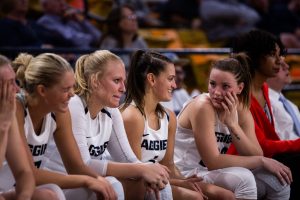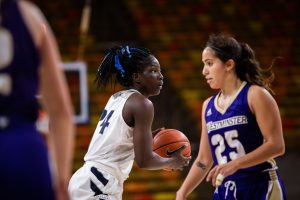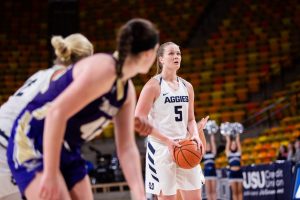89,000 Miles – BASKETBALL PREVIEW 2018
Her dark skin stands out in stark contrast to the crowd of white students around her. Statistically, maybe one in a hundred of them looks like her. She’s also taller than most of the men she walks by.
When she first arrived on the campus of Utah State University from her native country of Benin, in Africa, she wondered if she was the only black person on campus. In her words, Utah was very much a “white people state.”
Once through the crowd, Marlene Aniambossou makes her way to a locker room in the Dee Glen Smith Spectrum. There she will join the rest of her teammates on USU’s women’s basketball team. With them, she feels a sense of belonging. Not because any of them look like her — Aniambossou is the only black woman on the team — but because they are alike in another lonely way. Most of them are more than 10,000 miles from home too.
In that locker room, Aniambossou can look one way and see Roxani Bountouka, who is from Thessaloniki, Greece. Glancing in the opposite direction will give her a view of five Australian players, Eliza West, Olivia West (no relation), Steph Gorman, Shannon Dufficy and Rachel Brewster.

USU’s Rachel Brewster and Eliza West communicate on the bench during an exhibition contest against Westminster on November 2, 2018.
Seven of the Aggies’ 14 roster spots are taken up by players who hail from outside the borders of the United States. Only two are from Utah itself. And those seven women travelled a combined 89,340 miles — a distance that would take you around the Earth three and a half times — to play basketball in Logan, Utah.
Why?
Opportunity.
While basketball is arguably the most global sport in the world, American basketball reigns supreme and opportunities are boundless.
“Before,” Eliza West said, “I was just trying to be the best basketball player and just trying to play for my home club and then hopefully make an Australian program. But once I found out about college in America that became my number one goal.”
The U.S. does not lack teams for college-aged players. In the 2017-18 season the NCAA set new records for Division I women’s basketball teams (349), total games played (5,283) and total attendance (8,567,490) according to their report for the season.
“Here it’s a huge thing.” Bountouka said. “So, I really like it here because more people are interested. There is more organization. We don’t’ have college teams or high school teams, we have clubs.”
College programs in the U.S. can provide women with a springboard to launch a professional career, just like the men’s Division I programs. Aniambossou’s plan is to eventually make it to the WNBA. It’s something she takes seriously, and it requires a level of commitment she wouldn’t have had back in Benin.
“Back home you just play for fun, you just do whatever you want,” Aniambossou said. “When I came here, I set goals. I needed to improve myself. I wasn’t this athletic when I was back home, I was just playing around. But when I came here I took things seriously and kept working on myself.”

USU’s Marlene Aniambossou looks to pass the ball against Westminster early in the 2018-19 season.
It isn’t just the chance to turn pro that draws international players. Bountouka said she is unsure about what she plans to do with her basketball career but didn’t think twice about her decision because in addition to furthering her playing career, she would also get free access a high-level education that wouldn’t be available otherwise.
“In Greece there aren’t many opportunities in basketball or studies at this time,” Bountouka said. “So, the whole package was great, so I just had to take it, it was obvious.”
While traveling abroad to play basketball and have a quality education fully paid for are two huge positives, there is still the negative of being so far away from home.
“Coming over here, I was obviously really nervous,” Dufficy said. “It was a big change, moving far away from home.”

USU’s Shannon Dufficy, a native of Australia, attempts a free throw against Westminster
That sacrifice is not lost on the American-born players.
“It’s really interesting to me because I’m a homebody and I go home quite a bit,” said junior forward Hailey Bassett-Meacham, who grew up in Layton, Utah. “I think it’s awesome how they took the risk to come all the way to America.”
The differences are small but numerous. Bountouka said “almost everything” is different from her native Greece. Little things like clothes, behaviors, and mannerisms.
In addition to the American culture, many of these players have had to adjust to small-town life. Players like Bountouka and Brewster come from big cities with dense populations. USU women’s basketball head coach Jerry Finkbeiner compared Australian cities like Melbourne and Sydney to U.S. cities like Chicago and Los Angeles.
However, Finkbeiner said living abroad in a small town could be more beneficial than going big-city America.
“I think the small-town nature makes it nicer for these kids to come over,” Finkbeiner said.
“The small-town nature of people and safety and those kinds of things are a pleasant surprise and the comfort zone goes up really quick.”

USU head coach Jerry Finkbeiner instructs his team during a timeout against Westminster Friday night.
Over the summer, though, the coaching staff did even more to expedite the process of acclimating their players both to Utah life and to each other. This bonding time became known as “Aggie Adventures.” Each weekend the team would go somewhere to do nothing more than have a good time together. Whether it was golfing, horseback riding or hiking, these women got to know each other through experience.
Now, a team that was once separated by nearly 90,000 miles is closer than ever before.
“We all get along like we’ve all grown up together,” Dufficy said. “You go in the locker room and, apart from the accents, you wouldn’t know the difference between where anyone’s from.”

